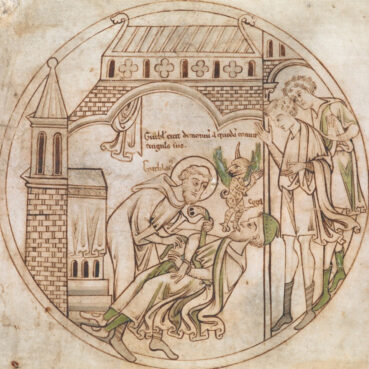(RNS) — On Thursday evening, my wife and I went to Trinity College’s splendid Cinestudio for a special pre-Halloween screening of “The Exorcist,” which neither of us had ever seen when it was released in 1973, or since. William Peter Blatty’s screen adaptation of his best-selling 1971 novel is about (in case you don’t know) a case of demonic possession that takes place in and around a tony Washington townhouse.
Pazuzu, the demon in question, seems to have been let loose unknowingly by archeologists at a dig in Iraq run by a Catholic priest, played by Max von Sydow. It takes possession of the pubescent daughter (Linda Blair) of a single mom Hollywood star (Ellen Burstyn) who’s acting in a movie about a student anti-war protest that’s being filmed on the Georgetown University campus.
The heavy demonic action takes place in the girl’s bedroom. No question about it, Pazuzu is evil incarnate and — spoiler alert — will be responsible for the deaths of the movie’s director and the two priests who do the exorcism.
A half-century on, “The Exorcist” feels like an anti-Vatican II protest. His four marriages notwithstanding, Blatty was a conservative Catholic who, in 2012, filed a canon law petition against Georgetown (his alma mater) for violating church teaching by inviting abortion rights advocates to speak. “There are demons running all over that campus,” he told an interviewer.
The movie’s heartthrob priest (Jason Miller) is a psychiatrist who studied at Harvard and Oxford, disbelieves in demonic possession and has lost his faith — though before he dies he presumably regains it as a result of confronting Pazuzu. In other words, Blatty wants that old-time Catholicism back. Supernaturalism Sí! Aggiornamento No!
In fact, that old-time Catholicism took a less harrowing view of demonic possession than “The Exorcist.” The cases I’m familiar with (from books written in the 12th and 13th centuries, I hasten to add) involve much more community-minded demons than Pazuzu.
In written accounts by the likes of Parisian master Peter the Chanter, Cistercian abbot Caesarius of Heisterbach and Cardinal James of Vitry, demoniacs are distinguished particularly by the fact that they publicize people’s hidden sins. If you’ve secretly sinned and happen to be in his or her presence, the demoniac will let the cat out of the bag — unless you’ve managed to confess the sin yourself.

St Guthlac, left, performs a medieval exorcism. (Image courtesy of British Library/Creative Commons)
Caesarius, for example, tells the story of a priest who has been having an affair with a knight’s wife. Suspicious, the knight arranges to go with the priest to a nearby village where a demoniac is holding forth on the sins that “had not been concealed through true confession” of those who came into his presence. On the way, the priest, realizing what was afoot and fearing for his life, pretended a call of nature and hurried into a stable where he begged one of the knight’s servants to hear his confession.
With a new sense of security, the priest returned to the knight and together they entered the church where the demoniac was. When the knight asked about the priest, the demoniac said in German, “I know nothing of him,” adding in Latin (which the knight didn’t understand), “He was justified in the stable.”
Examples of this sort were told in order to encourage lay people to go to Confession, which in those days was so rare an occurrence that in 1215, the Fourth Lateran Council issued a mandate that all Christians had to do so once a year. The demoniacs, or at least the stories about them, thus served to spur this ecclesiastical project.
We also have examples of demons going so far as to warn people away from sin. Caesarius tells another story about a priest’s concubine who, repenting her sins, became a recluse. When a local (married) knight pays court to her and she agrees to an assignation, a possessed woman who lives nearby comes to her cell and berates her for what she is about to do. The demoniac then goes to the knight and berates him as well, thereby preventing the adultery.
Caesarius himself seems somewhat perplexed by the story, which was told to him by a monk who testified that he’d heard it from the recluse herself. The abbot sums it up by averring that the two would-be sinners were saved “through the grace of Christ and the ministry of the devil.”
Then there’s the story passed on by the Welsh chronicler Walter Map, from a clerk named John of Platena. It seems that John was annoyed at hearing some Cistercian abbots on a visit to Archbishop of Canterbury Thomas Becket praising “to the stars” their order’s hero, St. Bernard of Clairvaux. So John recounted the “miracle” of a demoniac who was brought to Bernard to be exorcized. Unbound, the demoniac hurled stones at the saint and chased him through the town until subdued.
“So this is your miracle?” asked the archbishop, displeased. “Certainly,” replied John. “Those present said that this was a noteworthy miracle, because the possessed man was mild and friendly to everyone, and troublesome only to the hypocrite, and therefore this was in my view a punishment of presumptuousness.”
Happy Halloween!


